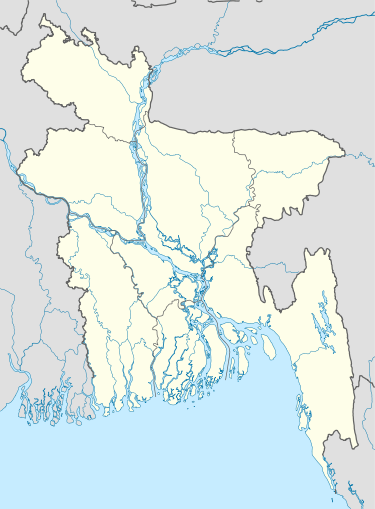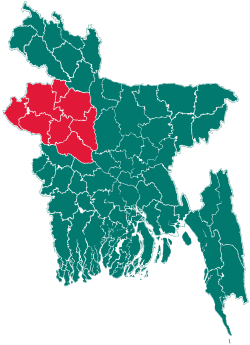Ullahpara Upazila
| Ullahpara Upazila | |
|---|---|
 Location in Bangladesh | |
| Coordinates: 24°19.2′N 89°34′E / 24.3200°N 89.567°ECoordinates: 24°19.2′N 89°34′E / 24.3200°N 89.567°E | |
| Country |
|
| Division | Rajshahi Division |
| District | Sirajganj District |
| Area | |
| • Total | 414.43 km2 (160.01 sq mi) |
| Population (1991) | |
| • Total | 399,074 |
| • Density | 963/km2 (2,490/sq mi) |
| Time zone | BST (UTC+6) |
| Website | Official Map of Ullahpara |
Ullapara (Bengali: উল্লাপাড়া) is an Upazila of Sirajganj District in the Division of Rajshahi, Bangladesh. Ullapara is known as the gateway to North Bengal as the intersection of Dhaka-Rangpur and Dhaka-Rajshahi highways at Hatikumrul falls within it.
Geography
Ullapara is located at 24°19′10″N 89°34′00″E / 24.3194°N 89.5667°E, on the western bank of the river Karotoa. It has 69479 units of household and total area 414.43 km². Ullapara is created on alluvial soil deposited by Padma, Jamuna and some other rivers e.g. Bhrammaputra, Karotoa, Fulzor etc. Raiganj and Tarash upazila are on north, Tarash and Bhangura are on west, Faridpur and Shahjadpur are on south, Belkuchi and Kamarkhanda are on east of the upazila. Its height from the sea level is 10–12 feet. The flowing rivers over it are Karotoa, Fulzor, Jopjopia, Kamla Dargadoh, etc. The highest and lowest temperature is 35 °Celsius and 21 °Celsius. About 90% of total rainfall occurs in the rainy season. The annual average rainfall is 170–190 cm.
History
Exact history of development of Ullapara region is not available. But according to most geologists, in 4500 B.C., the land of Varendra was built with the parts of Dinajpur, Joypurhat, Bogra and Rajshahi and the west parts of Pabna. For many centuries, Pabna and Mymensingh were built on alluvial soil deposited by those rivers. At that time, there was no Jamuna River and Sirajganj and Tangail were part of Mymensingh. According to Chinese tourist Huen Sang, the people survived in Sirajgonj for seven centuries. Then the river Jamuna appeared separating this area from greater Mymensingh. Then, the new land of this region was under water for eight or nine months of the year. According to Huen Sang, the western bank of the Karotoa river was in the Pundrabardhan Kingdom. By this estimate, Ullapara was also in this kingdom. A connection was established with Ullapara by paths of water and land in the era of Muslim Administration (1204-1757) and the time of British (1757-1947) and finally a business center was established. Later in 1875 a thana was established here and finally on July 02, 1983 it got the recognition of Upazilla.
Demographics
As of the 1991 Bangladesh census, Ullapara has a population of 3,99,074. Males constitute 51.13% of the population, and females 48.87%. This Upazila's eighteen up population is 192188. Ullapara has an average literacy rate of 32.2% (7+ years), compared to the national average of 82.4%.[1]
Administration
Upazila Nirbahi Officer is the administrative head of the Upazila posted by the government while Upazila Chairman is the elected representative of the people, who is supposed to work for the development and welfare of the Upazila. Ullapara has 13 Unions/Wards, 264 Mauzas/Mahallas, and 425 villages. Each Union in turn has its elected Chairman.
Education
People were deprived of modern education till the beginning of the Twentieth Century. The oldest institution for secondary education- Ullapara Merchant's Pilot High English School was established in 1906 (by the jute merchants of the then small river port)Salop High School was established in 1905(by landlord ). Subsequently other educational institutes were set up, such as-Kaliakoir Adarsha High School, Ullapara Degree College, Govt. Akbar Ali College, Ullapara Science College, Momena Ali Science School, Hamida Pilot High School & College, Ghona Kuchia Mara College, Solonga College, Rajman High School, Baropangashi High School K.A.M High School, Ideal High School,,Scholastica Institute(Learning & Skill Development), Dharoil High School, Chengtia Technical and Business Management College,unukhan pagla peer High School,ramkrisnopure, Newargacha Girls school, Lahiri Mohanpur K.M. Institute etc. Akbar Ali College was the first College in the Upazila, established in 1970 by enthusiastic scholars and students of the region. The College was nationalised afterwards. There are 15 private college,, 43 high school, 146 govt. primary school, 105 private(Reg.) primary schools and 106 Brac schools in Ullapara. The people (majority being Muslims) are also interested in the traditional Islamic system of education'Education of Madrasha'. So, there are- 1 Kamil, 6 Fajil, 4 Alim, 42 Dakhil and 75 Eftadaye madrasha here. Md. Pear Mahmud, Md. Abul Kashem Mia, Md. Fazlul Karim Chowdhury is the 1st Graduate(1962) of Ullapara Thana. Md. Pear Mahmud is an retired district account's officer(DAO), Abul Kashem Mia is an retired headmaster & Md. Fazlul Karim Chowdhury is a retered general manager of habib bank, [Dhaka].
Communication
Riverine route was the only effective route of communication in the earlier days. Communication over the whole upazila is quite good nowadays. The Dhaka-Rangpur highway and Dhaka-Rajshahi railway connect the upazila(Village:Newargacha) with the other parts of the country. There is a good network of road communication throughout. After the commissioning of the rail-road bridge (the largest and longest in Bangladesh) over the river Jamuna at the end of last century, it takes around 3 hours now to reach Dhaka (the capital of the country) by road.
Notable Persons
Abdur Rashid Tarkabagish (Politician in British regime), Abdul Latif Mirza (Freedom fighter and MP), H T Imam (First cabinet secretary of the country and current political advisor of the Prime Minister), Akbar Ali (Educationist and MP) Fazle Lohani (Media Personnel)
See also
References
- ↑ "Population Census Wing, BBS.". Archived from the original on 2005-03-27. Retrieved November 10, 2006.
| |||||||||||||||||||||||||||||||||||||||||
